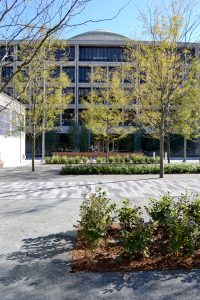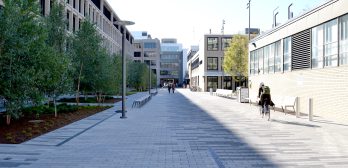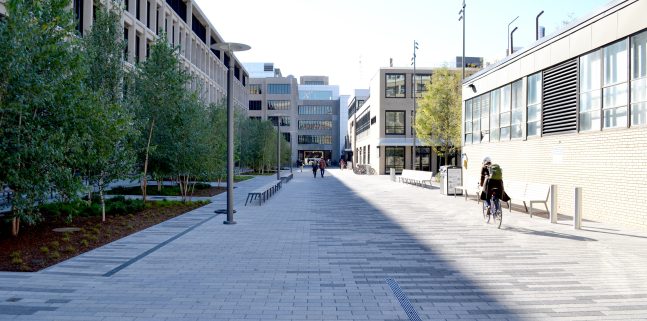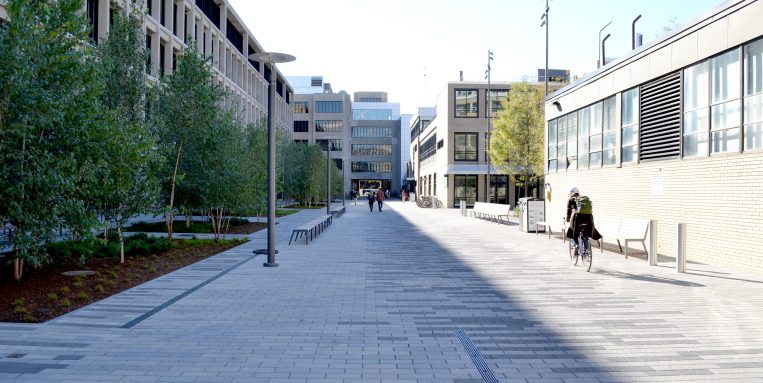Nitsch Engineering designed a new landscape filter approach that is more flexible for implementation in complex sites
The Massachusetts Institute of Technology (MIT) North Corridor project won a 2019 Engineering Excellence Silver Award from the American Council of Engineering Companies of Massachusetts (ACEC/MA) on March 20, 2019. The award recognized Nitsch Engineering for their unique approach to stormwater management, which included an innovative modification to a standard bioretention basin – an approach that Nitsch Engineering called a landscape filter.
Construction of the new MIT.nano building (Building 12) provided an opportune moment to reimagine the North Corridor: 1.48 acres of roadway that was demolished to support utility connections for the new facility. The new vision of a landscaped student space to enhance pedestrian connections and create a sense of place, while limiting vehicular access to delivery and emergency vehicles, made the project an ideal fit to serve as a pilot project for the implementation of innovative stormwater management strategies on the campus.
 The Nitsch Team identified and evaluated the benefits and limitations of a range of potential stormwater best management practices (BMPs) and pilot strategies that would meet MIT’s aggressive sustainability goals for the project. Through a collaborative design process with the landscape architect, Reed Hilderbrand, Nitsch Engineering designed the landscape filter. This new approach innovates the standard bioretention basin by using a “flexible filter” approach that works for urban sites with complex utilities and uncertain soil and groundwater conditions. The landscape filter looks like a small planted area, but uses below-grade distribution piping connected from trench drains that collect surface runoff. With design characteristics similar to bioretention basins, the landscape filters use plants and specialized soils to treat the runoff from adjacent impervious areas.
The Nitsch Team identified and evaluated the benefits and limitations of a range of potential stormwater best management practices (BMPs) and pilot strategies that would meet MIT’s aggressive sustainability goals for the project. Through a collaborative design process with the landscape architect, Reed Hilderbrand, Nitsch Engineering designed the landscape filter. This new approach innovates the standard bioretention basin by using a “flexible filter” approach that works for urban sites with complex utilities and uncertain soil and groundwater conditions. The landscape filter looks like a small planted area, but uses below-grade distribution piping connected from trench drains that collect surface runoff. With design characteristics similar to bioretention basins, the landscape filters use plants and specialized soils to treat the runoff from adjacent impervious areas.
The landscape filter system is transferrable to other urban spaces that could benefit from increased green space, and allows the design team to replicate the treatment that can be provided by porous asphalt or bioretention basins within a site that doesn’t have the conditions to support either practice. This design was flexible enough to allow for easy changes during construction when utility conflicts were discovered, which allows for a broad range of environments in which this design can be applied. This approach to stormwater mitigation can be applied to stretch the limits of urban engineering when it comes to creating more usable and resilient outdoor space.
The landscape filter’s design allowed the team to exceed the stormwater mitigation goals for the North Corridor project, while creating a campus amenity and helping MIT address concerns about the stronger and more frequent storm events associated with climate change. The project’s goal was to reduce phosphorus loads by 65% across the site; Nitsch Engineering’s design achieved 70% reduction in phosphorus. The design also met the goal of reducing peak rate and volume of stormwater discharges by 40%. Students and faculty benefit from an increased tree canopy and green space on MIT’s campus, converting what was previously industrial-oriented space into a pedestrian corridor and gathering area.



